适配器模式(Adapter)
adapter用法

adapter用法Adapter是一种常用的设计模式,用于将一个类的接口转换成另一个类所期望的接口。
它可以解决两个不兼容接口之间的兼容性问题。
在软件开发中,Adapter模式可以用于多种场景,下面我将从多个角度来介绍Adapter的用法。
1. 结构和工作原理:Adapter模式由三个主要组件组成,目标接口(Target)、适配器(Adapter)和被适配者(Adaptee)。
目标接口定义了客户端所期望的接口,适配器实现了目标接口,并持有一个被适配者的引用,通过适配器将客户端的请求转发给被适配者。
2. 类适配器和对象适配器:Adapter模式有两种常见的实现方式,类适配器和对象适配器。
类适配器使用继承来实现适配器,它继承了目标接口和被适配者,并在适配器中实现目标接口的方法。
对象适配器使用组合来实现适配器,它持有一个被适配者的引用,并在适配器中实现目标接口的方法。
3. 应用场景:Adapter模式可以应用于以下场景:在现有系统中使用第三方库或组件,但其接口与系统的接口不兼容时,可以使用适配器来进行接口转换。
在系统演化过程中,为了避免对现有代码的修改,可以使用适配器来兼容旧接口和新接口。
在系统需要与多个不同接口的类进行交互时,可以使用适配器统一接口,提供一致的访问方式。
4. 优点和缺点:Adapter模式的优点包括:提供了灵活的接口转换,使得原本不兼容的类可以协同工作。
可以使系统具有良好的扩展性和维护性,减少对现有代码的修改。
然而,Adapter模式也存在一些缺点:增加了系统的复杂性,引入了额外的类和对象。
在适配器过多的情况下,可能导致系统结构混乱。
总结:Adapter模式是一种常用的设计模式,用于解决不兼容接口之间的兼容性问题。
它可以通过类适配器或对象适配器的方式实现。
Adapter模式在软件开发中应用广泛,可以用于整合第三方库、兼容旧接口、统一多个接口等场景。
它具有灵活性和扩展性的优点,但也可能增加系统的复杂性。
adapter 概念 -回复

adapter 概念-回复标题:理解与应用——[Adapter 概念]的全面解析一、引言在软件开发中,我们经常遇到各种各样的问题和挑战。
有时候,我们需要处理一些不兼容的接口或者系统,这时候就需要用到Adapter模式。
Adapter模式是设计模式中的结构型模式之一,它的主要作用就是将一个类的接口转换成客户希望的另一个接口。
这篇文章将会从概念、原理、应用等方面详细介绍Adapter模式。
二、Adapter模式的概念Adapter模式,又称为适配器模式,是一种常见的设计模式。
它的主要目的是通过创建一个新的对象来解决接口不兼容的问题。
这个新的对象(也就是Adapter)包装了一个现有的对象,并且提供了一个新的接口给客户端使用。
这样,客户端就可以通过新的接口来调用现有的对象,而不需要直接和现有对象进行交互。
三、Adapter模式的原理Adapter模式的工作原理非常简单。
首先,它有一个需要被适配的对象,也就是Adaptee。
然后,它创建一个新的对象,也就是Adapter,这个对象包含了Adaptee的一个实例。
最后,Adapter提供了客户端需要的接口,这个接口的实现实际上是调用了Adaptee的方法。
四、Adapter模式的应用Adapter模式在实际开发中有广泛的应用。
例如,在Java开发中,我们可以使用Adapter模式来处理不同版本的JDBC驱动。
另外,Adapter 模式还可以用来处理不同的数据格式,例如将XML数据转换为JSON数据。
五、Adapter模式的优点和缺点Adapter模式的优点非常明显。
首先,它可以让不兼容的接口变得兼容,解决了接口不一致的问题。
其次,Adapter模式使得代码更加灵活,因为我们可以随时更换Adapter,而不影响客户端的代码。
最后,Adapter模式可以提高代码的复用性,因为我们可以为不同的Adaptee创建相同的Adapter。
然而,Adapter模式也有一些缺点。
适配器模式和组合模式的比较

适配器模式和组合模式的比较适配器模式和组合模式都是常用的设计模式,它们在实际开发中经常被用到。
虽然这两种模式看起来很像,但它们的作用和实现方式有很大的区别。
在本文中,我们将介绍适配器模式和组合模式的比较。
一、适配器模式适配器模式是一种结构性设计模式,它能够将不兼容的接口转换成另一种接口,使得不同类之间能够相互协作。
适配器模式的核心思想是将一个类的接口,转换成客户端所期望的另一种接口,从而使得原本不兼容的类能够协同工作。
适配器模式的实现方式通常有两种:类适配器和对象适配器。
其中,类适配器使用继承机制对源接口进行扩展,而对象适配器则是使用组合机制来实现接口转换。
适配器模式的应用场景比较广泛,例如在使用第三方库时,可能会遇到接口不兼容的情况,此时就可以使用适配器模式来解决这个问题。
二、组合模式组合模式是一种结构性设计模式,它将对象组合成树形结构,使得用户无需区分单个对象和组合对象,从而可以统一地处理所有对象。
组合模式的核心思想是将对象组合成树形结构,从而将复杂的对象模型简化为单一的对象结构。
组合模式的实现方式通常有两种:透明组合模式和安全组合模式。
其中,透明组合模式是将叶子对象和组合对象都看做一种对象,从而对外具体透明,而安全组合模式则是将叶子对象和组合对象分开处理,从而增强了类型安全。
组合模式的应用场景比较广泛,例如在操作文件系统时,可能会遇到需要同时操作文件和目录的情况,此时就可以使用组合模式来解决这个问题。
三、适配器模式和组合模式的比较适配器模式和组合模式都是常用的设计模式,它们在实际开发中经常被用到。
虽然这两种模式看起来很像,但它们的作用和实现方式有很大的区别。
首先,适配器模式的主要作用是将不兼容的接口转换成另一种接口,从而使得不同类之间能够相互协作。
而组合模式的主要作用是将对象组合成树形结构,从而可以统一地处理所有对象。
其次,适配器模式通常使用继承或组合机制来实现接口转换,而组合模式则是使用组合机制来实现对象的组合。
代理模式和适配器模式的对比

代理模式和适配器模式的对比介绍软件开发一直是一个变化规律极为频繁的行业,随着时间的推移,软件设计模式被广泛应用于软件开发。
设计模式是一种特殊的代码重构技巧,它们被设计用于解决一些在软件开发中经常遇到的问题。
其中代理模式和适配器模式是两种常见的设计模式。
本文将对它们进行对比探讨,旨在深入了解它们之间的异同点。
代理模式代理模式(Proxy Pattern)是软件开发中的一种设计模式,它的目的是通过使用一个代理对象来控制对设计对象的访问。
代理是对象的一个抽象,可以在原对象之前进行前置处理,在原对象之后进行后置处理,并且不影响原对象的逻辑实现。
例如,假设我们需要访问一个网络资源,而这个资源的访问需要耗费大量的时间和数据带宽。
在这种情况下,我们可以使用代理模式,将代理对象作为访问网络资源的入口,代理对象会负责从网络中加载必要的资源。
此外,代理模式还可以用于实现权限和安全控制。
适配器模式适配器模式(Adapter Pattern)是软件开发中的一种设计模式,它的目的是在不改变现有代码的基础上,将不兼容的对象包装到一个可用对象中。
适配器模式主要用于解决两个接口不兼容的问题,可以将不同的接口封装到一个通用的接口中,从而可以实现彼此之间的协作。
例如,在一个应用中,我们可能需要将一些数据从一个数据源中提取出来,并将其转换为另一种格式,以便在另一个应用中使用。
在这种情况下,我们可以使用适配器模式来实现数据的转换和传输。
对比代理模式和适配器模式都是常见的设计模式,它们在实际的软件开发中有不同的应用场景。
首先,代理模式和适配器模式的目的和实现方式不同。
代理模式的目的是在原有的基础上添加额外的控制和安全性,而适配器模式的目的是实现两个不兼容的接口之间的协作。
代理模式通过在原对象之前和之后进行前置和后置处理来实现额外控制的目的。
其次,代理模式和适配器模式的实现方式不同。
适配器模式通过将不兼容的对象包装在一个可用的对象中来实现数据转换和传输的目的。
适配器的作用
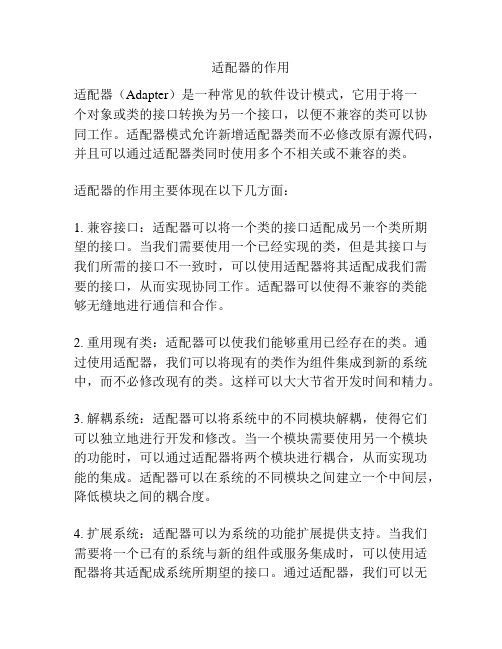
适配器的作用适配器(Adapter)是一种常见的软件设计模式,它用于将一个对象或类的接口转换为另一个接口,以便不兼容的类可以协同工作。
适配器模式允许新增适配器类而不必修改原有源代码,并且可以通过适配器类同时使用多个不相关或不兼容的类。
适配器的作用主要体现在以下几方面:1. 兼容接口:适配器可以将一个类的接口适配成另一个类所期望的接口。
当我们需要使用一个已经实现的类,但是其接口与我们所需的接口不一致时,可以使用适配器将其适配成我们需要的接口,从而实现协同工作。
适配器可以使得不兼容的类能够无缝地进行通信和合作。
2. 重用现有类:适配器可以使我们能够重用已经存在的类。
通过使用适配器,我们可以将现有的类作为组件集成到新的系统中,而不必修改现有的类。
这样可以大大节省开发时间和精力。
3. 解耦系统:适配器可以将系统中的不同模块解耦,使得它们可以独立地进行开发和修改。
当一个模块需要使用另一个模块的功能时,可以通过适配器将两个模块进行耦合,从而实现功能的集成。
适配器可以在系统的不同模块之间建立一个中间层,降低模块之间的耦合度。
4. 扩展系统:适配器可以为系统的功能扩展提供支持。
当我们需要将一个已有的系统与新的组件或服务集成时,可以使用适配器将其适配成系统所期望的接口。
通过适配器,我们可以无缝地将新的组件或服务集成到系统中,从而实现功能的扩展。
5. 改进系统性能:适配器可以对不同的类进行性能优化。
当我们需要使用一个性能更好的类来替代原有的类时,可以使用适配器将新的类适配成原有类的接口,从而实现对系统性能的改进。
总之,适配器是一种非常有用的软件设计模式,它可以将不兼容的类适配成可协同工作的接口,允许新增适配器类而不必修改原有源代码,使得不同模块之间能够独立开发和修改,同时也能提高系统的性能和功能扩展能力。
适配器的应用可以在复杂的软件系统中解决接口的不兼容问题,提高系统的灵活性和可维护性。
8.Adapter适配器模式
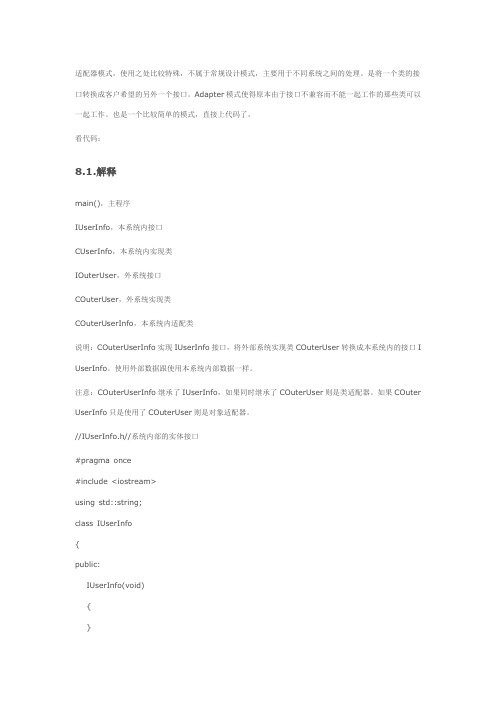
适配器模式,使用之处比较特殊,不属于常规设计模式,主要用于不同系统之间的处理。
是将一个类的接口转换成客户希望的另外一个接口。
Adapter模式使得原本由于接口不兼容而不能一起工作的那些类可以一起工作。
也是一个比较简单的模式,直接上代码了。
看代码:8.1.解释main(),主程序IUserInfo,本系统内接口CUserInfo,本系统内实现类IOuterUser,外系统接口COuterUser,外系统实现类COuterUserInfo,本系统内适配类说明:COuterUserInfo实现IUserInfo接口,将外部系统实现类COuterUser转换成本系统内的接口I UserInfo。
使用外部数据跟使用本系统内部数据一样。
注意:COuterUserInfo继承了IUserInfo,如果同时继承了COuterUser则是类适配器。
如果COuter UserInfo只是使用了COuterUser则是对象适配器。
//IUserInfo.h//系统内部的实体接口#pragma once#include <iostream>using std::string;class IUserInfo{public:IUserInfo(void){}virtual ~IUserInfo(void){}virtual string GetUserName() = 0;virtual string GetHomeAddress() = 0;virtual string GetMobileNumber() = 0;virtual string GetOfficeTelNumber() = 0;virtual string GetJobPosition() = 0;virtual string GetHomeTelNumber() = 0; };//UserInfo.h//系统内部实体类#pragma once#include "iuserinfo.h"#include <iostream>using std::string;class CUserInfo :public IUserInfo{public:CUserInfo(void);~CUserInfo(void);string GetUserName();string GetHomeAddress();string GetMobileNumber();string GetOfficeTelNumber();string GetJobPosition();string GetHomeTelNumber();};//UserInfo.cpp#include "StdAfx.h"#include "UserInfo.h"#include <iostream>using std::cout;using std::endl;using std::string;CUserInfo::CUserInfo(void){}CUserInfo::~CUserInfo(void){}string CUserInfo::GetUserName(){cout << "姓名叫做..." << endl;return "0";}string CUserInfo::GetHomeAddress(){cout << "这里是员工的家庭地址..." << endl;return "0";}string CUserInfo::GetMobileNumber(){cout << "这个人的手机号码是0000..." << endl;return "0";}string CUserInfo::GetOfficeTelNumber(){cout << "办公室电话是..." << endl;return "0";}string CUserInfo::GetJobPosition(){cout << "这个人的职位是BOSS..." << endl;return "0";}string CUserInfo::GetHomeTelNumber(){cout << "员工的家庭电话是..." << endl;return "0";}//IOuterUser.h//外部系统实体接口#pragma once#include "OuterUserBaseInfo.h"#include "OuterUserHomeInfo.h"#include "OuterUserOfficeInfo.h"class IOuterUser{public:IOuterUser(void){}~IOuterUser(void){}COuterUserBaseInfo * GetUserBaseInfo();COuterUserHomeInfo * GetUserHomeInfo();COuterUserOfficeInfo * GetUserOfficeInfo(); };//OuterUser.h//外部系统实体类#pragma once#include "OuterUserBaseInfo.h"#include "OuterUserHomeInfo.h"#include "OuterUserOfficeInfo.h"class COuterUser{public:COuterUser(void){}~COuterUser(void){}COuterUserBaseInfo * GetUserBaseInfo();COuterUserHomeInfo * GetUserHomeInfo();COuterUserOfficeInfo * GetUserOfficeInfo(); };//OuterUser.cpp#include "StdAfx.h"#include "OuterUser.h"#include "OuterUserBaseInfo.h"#include "OuterUserHomeInfo.h"#include "OuterUserOfficeInfo.h"COuterUser::COuterUser(void){}COuterUser::~COuterUser(void){}COuterUserBaseInfo * COuterUser::GetUserBaseInfo() {return new COuterUserBaseInfo();}COuterUserHomeInfo * COuterUser::GetUserHomeInfo() {return new COuterUserHomeInfo();}COuterUserOfficeInfo * COuterUser::GetUserOfficeInfo() {return new COuterUserOfficeInfo();}//OuterUserBaseInfo.h#pragma once#include <iostream>using std::endl;using std::string;class COuterUserBaseInfo{public:COuterUserBaseInfo(void){}~COuterUserBaseInfo(void){}string GetUserName(){cout << "姓名叫做..." << endl;return "0";}string GetMobileNumber(){cout << "这个人的手机号码是0001..." << endl;return "0";}};//OuterUserHomeInfo.h#pragma once#include <iostream>using std::cout;using std::string;class COuterUserHomeInfo{public:COuterUserHomeInfo(void){}~COuterUserHomeInfo(void){}string GetHomeAddress(){cout << "这里是员工的家庭地址..." << endl;return "0";}string GetHomeTelNumber(){cout << "员工的家庭电话是..." << endl;return "0";}};//OuterUserOfficeInfo.h#pragma once#include <iostream>using std::cout;using std::endl;class COuterUserOfficeInfo{public:COuterUserOfficeInfo(void){}~COuterUserOfficeInfo(void){}string GetOfficeTelNumber(){cout << "办公室电话是..." << endl;return "0";}string GetJobPosition(){cout << "这个人的职位是BOSS..." << endl;return "0";}};//OuterUserInfo.h//由IUserInfo接口派生的实体类,并引入外部系统实体的实例#pragma once#include "iuserinfo.h"#include "OuterUser.h"#include <iostream>using std::string;class COuterUserInfo :public IUserInfo{public:COuterUserInfo(void);~COuterUserInfo(void);string GetUserName();string GetHomeAddress();string GetMobileNumber();string GetOfficeTelNumber();string GetJobPosition();string GetHomeTelNumber(); private:COuterUser *m_pOuterUser;};//OuterUserInfo.cpp#include "StdAfx.h"#include "OuterUserInfo.h"#include "OuterUserBaseInfo.h"#include "OuterUserHomeInfo.h"#include "OuterUserOfficeInfo.h"#include <iostream>using std::cout;using std::endl;using std::string; COuterUserInfo::COuterUserInfo(void) {m_pOuterUser = new COuterUser();COuterUserInfo::~COuterUserInfo(void){delete m_pOuterUser;}string COuterUserInfo::GetUserName(){COuterUserBaseInfo *pBaseInfo = m_pOuterUser->GetUserBaseInfo();pBaseInfo->GetUserName();delete pBaseInfo;pBaseInfo = NULL;return "0";}string COuterUserInfo::GetHomeAddress(){COuterUserHomeInfo *pHomeInfo = m_pOuterUser->GetUserHomeInfo();pHomeInfo->GetHomeAddress();delete pHomeInfo;pHomeInfo = NULL;return "0";}string COuterUserInfo::GetMobileNumber(){COuterUserBaseInfo *pBaseInfo = m_pOuterUser->GetUserBaseInfo();pBaseInfo->GetMobileNumber();delete pBaseInfo;pBaseInfo = NULL;return "0";string COuterUserInfo::GetOfficeTelNumber(){COuterUserOfficeInfo *pOfficeInfo = m_pOuterUser->GetUserOfficeInfo();pOfficeInfo->GetOfficeTelNumber();delete pOfficeInfo;pOfficeInfo = NULL;return "0";}string COuterUserInfo::GetJobPosition(){COuterUserOfficeInfo *pOfficeInfo = m_pOuterUser->GetUserOfficeInfo();pOfficeInfo->GetJobPosition();delete pOfficeInfo;pOfficeInfo = NULL;return "0";}string COuterUserInfo::GetHomeTelNumber(){COuterUserHomeInfo *pHomeInfo = m_pOuterUser->GetUserHomeInfo();pHomeInfo->GetHomeTelNumber();delete pHomeInfo;pHomeInfo = NULL;return "0";}//Adapter.cpp//使用方法#include "stdafx.h"#include "IOuterUser.h"#include "IUserInfo.h"#include "UserInfo.h"#include "OuterUserInfo.h"void DoIt(){IUserInfo *pYourGirl = new CUserInfo();for(int i = 0; i < 101; i += 20){pYourGirl->GetMobileNumber();}delete pYourGirl;}void NowDoIt(){IUserInfo *pYourGirl = new COuterUserInfo();for(int i = 0; i < 101; i += 20){pYourGirl->GetMobileNumber();}delete pYourGirl;}int _tmain(int argc, _TCHAR* argv[]){DoIt();NowDoIt();_CrtSetDbgFlag(_CRTDBG_LEAK_CHECK_DF | _CRTDBG_ALLOC_MEM_DF);_CrtDumpMemoryLeaks();return 0;}适配器模式属于结构型模式,当出现数据接口不一致的情况下,才会使用到。
adapter方法

adapter方法适配器模式适配器模式(Adapter Pattern)是一种结构型设计模式,使得不兼容的接口可以一起工作。
适配器模式允许对象以不同的接口表现,使得原本因接口不一致而无法在一起工作的类可以协同工作。
适配器方法适配器方法是适配器模式的一种具体实现方式。
它通过在原有接口和目标接口之间增加一个适配器来实现接口的转换。
类适配器类适配器使用继承关系来实现接口转换。
适配器类继承自原有类,并实现目标接口,从而使得原有类的方法可以通过目标接口调用。
类适配器的实现步骤:1.创建目标接口,即适配后期望的接口。
2.创建源接口,即需要适配的接口。
3.创建适配器类,继承源接口并实现目标接口,在适配器类中实现方法映射关系。
4.在适配器类中重写目标接口的方法,将调用具体方法的任务委托给源接口的方法。
示例代码:public interface Target {void request();}public class Adaptee {public void specificRequest() {// 具体请求的逻辑实现}}public class Adapter extends Adaptee implements Target { @Overridepublic void request() {specificRequest();}}public class Client {public static void main(String[] args) {Target target = new Adapter();();}}对象适配器对象适配器使用组合关系来实现接口转换。
适配器类持有源类的实例,并实现目标接口,从而使得源类的方法可以通过目标接口调用。
对象适配器的实现步骤:1.创建目标接口,即适配后期望的接口。
2.创建源接口,即需要适配的接口。
3.创建适配器类,持有源接口的实例并实现目标接口。
4.在适配器类中实现目标接口的方法,将调用具体方法的任务委托给源接口的方法。
一文彻底弄懂适配器模式(Adapter)
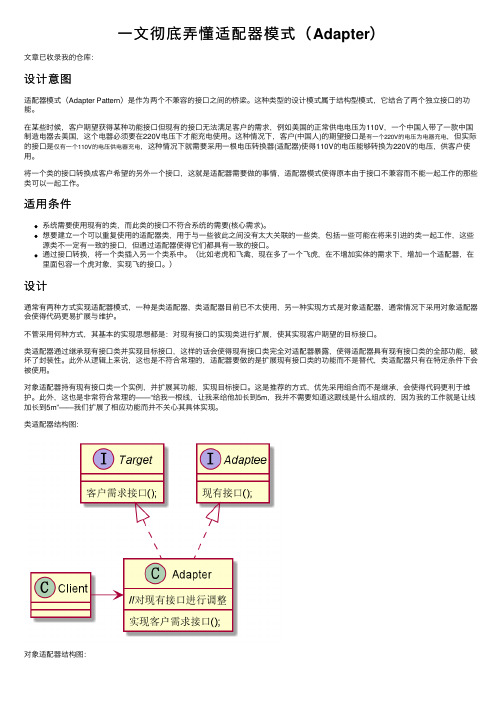
⼀⽂彻底弄懂适配器模式(Adapter)⽂章已收录我的仓库:设计意图适配器模式(Adapter Pattern)是作为两个不兼容的接⼝之间的桥梁。
这种类型的设计模式属于结构型模式,它结合了两个独⽴接⼝的功能。
在某些时候,客户期望获得某种功能接⼝但现有的接⼝⽆法满⾜客户的需求,例如美国的正常供电电压为110V,⼀个中国⼈带了⼀款中国制造电器去美国,这个电器必须要在220V电压下才能充电使⽤。
这种情况下,客户(中国⼈)的期望接⼝是有⼀个220V的电压为电器充电,但实际的接⼝是仅有⼀个110V的电压供电器充电,这种情况下就需要采⽤⼀根电压转换器(适配器)使得110V的电压能够转换为220V的电压,供客户使⽤。
将⼀个类的接⼝转换成客户希望的另外⼀个接⼝,这就是适配器需要做的事情,适配器模式使得原本由于接⼝不兼容⽽不能⼀起⼯作的那些类可以⼀起⼯作。
适⽤条件系统需要使⽤现有的类,⽽此类的接⼝不符合系统的需要(核⼼需求)。
想要建⽴⼀个可以重复使⽤的适配器类,⽤于与⼀些彼此之间没有太⼤关联的⼀些类,包括⼀些可能在将来引进的类⼀起⼯作,这些源类不⼀定有⼀致的接⼝,但通过适配器使得它们都具有⼀致的接⼝。
通过接⼝转换,将⼀个类插⼊另⼀个类系中。
(⽐如⽼虎和飞禽,现在多了⼀个飞虎,在不增加实体的需求下,增加⼀个适配器,在⾥⾯包容⼀个虎对象,实现飞的接⼝。
)设计通常有两种⽅式实现适配器模式,⼀种是类适配器,类适配器⽬前已不太使⽤,另⼀种实现⽅式是对象适配器,通常情况下采⽤对象适配器会使得代码更易扩展与维护。
不管采⽤何种⽅式,其基本的实现思想都是:对现有接⼝的实现类进⾏扩展,使其实现客户期望的⽬标接⼝。
类适配器通过继承现有接⼝类并实现⽬标接⼝,这样的话会使得现有接⼝类完全对适配器暴露,使得适配器具有现有接⼝类的全部功能,破坏了封装性。
此外从逻辑上来说,这也是不符合常理的,适配器要做的是扩展现有接⼝类的功能⽽不是替代,类适配器只有在特定条件下会被使⽤。
设计模式之适配器模式
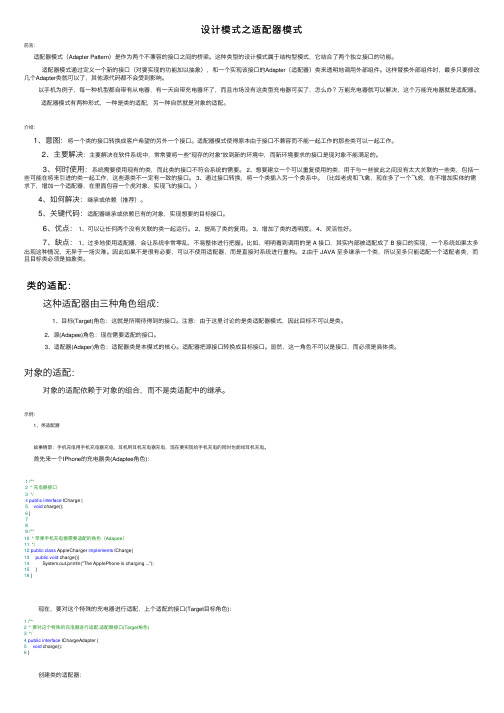
1 /**
2 * 充电器接口
3 */
4 public interface ICharge {
5 void charge();
6}
7
8
9 /**
10 * 苹果手机充电器需要适配的角色(Adapee)
11 */
12 public class AppleCharger implements ICharge{
1 /** 2 * 要对这个特殊的充电器进行适配,适配器接口(Target角色) 3 */ 4 public interface IChargeAdapter { 5 void charge(); 6}
创建类的适配器:
/** * 万能充电器,类的适配器(Adaper) */ public class UniversalCharger implements IChargeAdapter{
出现这种情况,无异于一场灾难。因此如果不是很有必要,可以不使用适配器,而是直接对系统进行重构。 2.由于 JAVA 至多继承一个类,所以至多只能适配一个适配者类,而 且目标类必须是抽象类。
类的适配: 这种适配器由三种角色组成: 1、目标(Target)角色:这就是所期待得到的接口。注意:由于这里讨论的是类适配器模式,因此目标不可以是类。
2、源(Adapee)角色:现在需要适配的接口。 3、适配器(Adaper)角色:适配器类是本模式的核心。适配器把源接口转换成目标接口。显然,这一角色不可以是接口,而必须是具体类。
对象的适配: 对象的适配依赖于对象的组合,而不是类适配中的继承。
示例: 1、类适配器 故事情景:手机充电用手机充电器充电,耳机用耳机充电器充电,现在要实现给手机充电的同时也能给耳机充电。
常见23种模式概述
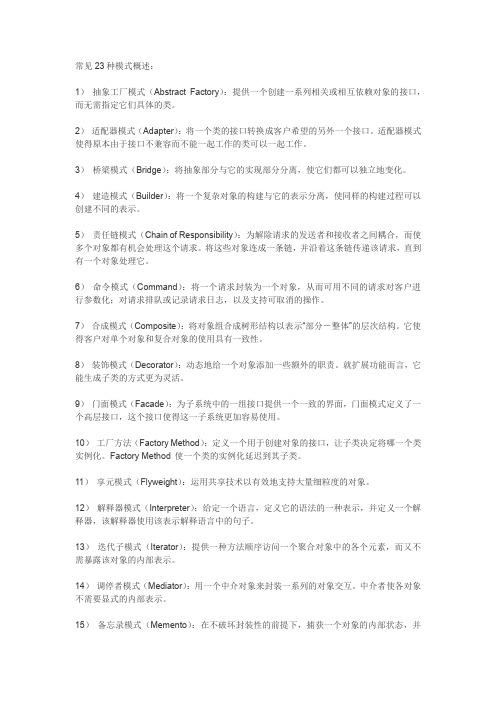
常见23种模式概述:1)抽象工厂模式(Abstract Factory):提供一个创建一系列相关或相互依赖对象的接口,而无需指定它们具体的类。
2)适配器模式(Adapter):将一个类的接口转换成客户希望的另外一个接口。
适配器模式使得原本由于接口不兼容而不能一起工作的类可以一起工作。
3)桥梁模式(Bridge):将抽象部分与它的实现部分分离,使它们都可以独立地变化。
4)建造模式(Builder):将一个复杂对象的构建与它的表示分离,使同样的构建过程可以创建不同的表示。
5)责任链模式(Chain of Responsibility):为解除请求的发送者和接收者之间耦合,而使多个对象都有机会处理这个请求。
将这些对象连成一条链,并沿着这条链传递该请求,直到有一个对象处理它。
6)命令模式(Command):将一个请求封装为一个对象,从而可用不同的请求对客户进行参数化;对请求排队或记录请求日志,以及支持可取消的操作。
7)合成模式(Composite):将对象组合成树形结构以表示“部分-整体”的层次结构。
它使得客户对单个对象和复合对象的使用具有一致性。
8)装饰模式(Decorator):动态地给一个对象添加一些额外的职责。
就扩展功能而言,它能生成子类的方式更为灵活。
9)门面模式(Facade):为子系统中的一组接口提供一个一致的界面,门面模式定义了一个高层接口,这个接口使得这一子系统更加容易使用。
10)工厂方法(Factory Method):定义一个用于创建对象的接口,让子类决定将哪一个类实例化。
Factory Method 使一个类的实例化延迟到其子类。
11)享元模式(Flyweight):运用共享技术以有效地支持大量细粒度的对象。
12)解释器模式(Interpreter):给定一个语言,定义它的语法的一种表示,并定义一个解释器,该解释器使用该表示解释语言中的句子。
13)迭代子模式(Iterator):提供一种方法顺序访问一个聚合对象中的各个元素,而又不需暴露该对象的内部表示。
java-适配器模式(adapter)

适配器模式(adapter)1.适配器模式(Adapter)的定义:在软件开发中,由于应用环境的变化,常常需要将“一些现存的对象”放在新的环境中应用,但是新环境的接口是现存对象所不满足的。
那么如何应对这种“迁移的变化”呢?如何利用现有对象的良好实现,同时又满足新的应用环境所要求的接口?这里说得就是Adapter模式。
2.意图:将一个类的接口转换成客户希望的另外一个接口,Adapter使得原本由于接口不兼容而不能一起工作的类可以一起共工作。
3.适配器模式的构成:1)目标抽象角色(Target):定义客户要用的特定领域的接口2)适配器(Adapter):调用另一个接口,作为转换器3)适配器(Adaptee):定义一个接口,Adapter需要接入4)客户端(Client):协同对相符合Adapter适配器4.适配器的分类:1)类适配器(采用集成的方式)2)对象适配器(采用对象组合的方式)-推荐3)缺省的适配器模式(AWT,Swing事件模型采用的模式)5.使用的场合:第一,对象需要使用现存的并且接口不兼容的类;第二,需要创建可重用的类以协调其他接口可能不兼容的类。
6.案例(通过类的继承模式):1)目标抽象角色(Target):package com.abao.adapter;public interface Target{public void method1();}2)适配器-Adapter需要接入:package com.abao.adapter;public class Adaptee{public void method2(){System.out.println("目标方法");}}3)适配器(Adapter):package com.abao.adapter;public class Adapter extends Adaptee implements Target {@Overridepublic void method1(){this.method2();}}4)客户端(Client):package com.abao.adapter;public class Client{public static void main(String[] args){Target target = new Adapter();target.method1();}}7.Junit中使用的额适配器模式:1)Junit在TestCase类中应用了适配器(Adapter)模式:2)在runBare方法中,通过runTest方法经我们自己编写的testXXX方法进行的适配,使得junit可以执行我们自己编写的Test Case,runTest方法的实现如下:8.案例(使用对象组合的方式实现适配器) 1)目标抽象角色(Target):package com.abao.adapter;public interface Target{public void method1();}2)适配器-Adapter需要接入:package com.abao.adapter;public class Adaptee{public void method2(){System.out.println("目标方法");}}3)适配器(Adapter)-这个地方就不是采用继承:package com.abao.adapter1;public class Adapter implements Target{private Adaptee adaptee;public Adapter(Adaptee adaptee){this.adaptee = adaptee;}@Overridepublic void method1(){adaptee.method2();}}4)客户端(Client):package com.abao.adapter1;public class Client{public static void main(String[] args){Target target = new Adapter(new Adaptee());target.method1();}}9.案例(缺省的适配器模式):1)抽象的接口服务角色:package com.abao.defaultadapter;public interface AbstractService{public void service1();public void service2();public void service3();}2)适配器角色(和swing比较几乎一样):package com.abao.defaultadapter;public class ServiceAdapter implements AbstractService {@Overridepublic void service1(){}@Overridepublic void service2(){}@Overridepublic void service3(){}}3)具体的服务角色:package com.abao.defaultadapter;public class ConcreteService extends ServiceAdapter{@Overridepublic void service1(){System.out.println("执行业务方法");}}10.上面的适配器模式和AWT、swing中的适配器的模式实现是完全一样的。
适配器模式的使用流程
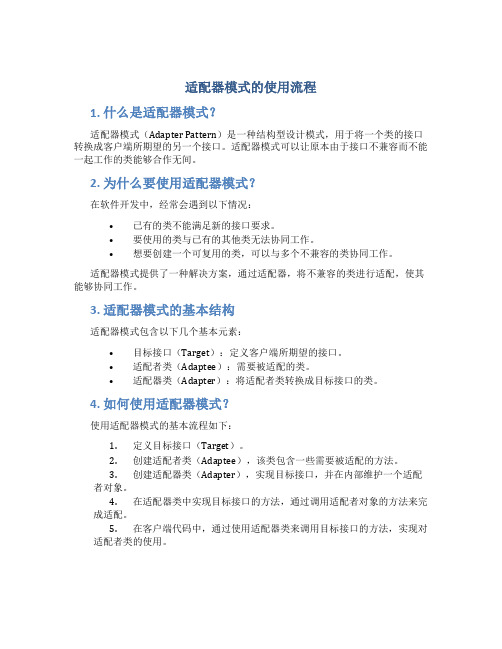
适配器模式的使用流程1. 什么是适配器模式?适配器模式(Adapter Pattern)是一种结构型设计模式,用于将一个类的接口转换成客户端所期望的另一个接口。
适配器模式可以让原本由于接口不兼容而不能一起工作的类能够合作无间。
2. 为什么要使用适配器模式?在软件开发中,经常会遇到以下情况:•已有的类不能满足新的接口要求。
•要使用的类与已有的其他类无法协同工作。
•想要创建一个可复用的类,可以与多个不兼容的类协同工作。
适配器模式提供了一种解决方案,通过适配器,将不兼容的类进行适配,使其能够协同工作。
3. 适配器模式的基本结构适配器模式包含以下几个基本元素:•目标接口(Target):定义客户端所期望的接口。
•适配者类(Adaptee):需要被适配的类。
•适配器类(Adapter):将适配者类转换成目标接口的类。
4. 如何使用适配器模式?使用适配器模式的基本流程如下:1.定义目标接口(Target)。
2.创建适配者类(Adaptee),该类包含一些需要被适配的方法。
3.创建适配器类(Adapter),实现目标接口,并在内部维护一个适配者对象。
4.在适配器类中实现目标接口的方法,通过调用适配者对象的方法来完成适配。
5.在客户端代码中,通过使用适配器类来调用目标接口的方法,实现对适配者类的使用。
5. 适配器模式的实例假设我们正在开发一个音乐播放器,需要支持多种格式的音频文件,包括MP3、WAV和FLAC。
现在我们已经有了一个已经实现了MP3播放的类MP3Player,但是我们的播放器需要支持所有三种格式的音频文件。
首先,我们定义目标接口AudioPlayer:•play(file: string): void:播放音频文件。
接下来,创建适配者类MP3Player:class MP3Player {playMP3(file: string): void {console.log(`播放MP3音频文件 ${file}`);}}然后,创建适配器类AudioPlayerAdapter,实现目标接口,并在内部维护一个MP3Player对象:class AudioPlayerAdapter implements AudioPlayer {private mp3Player: MP3Player;constructor() {this.mp3Player = new MP3Player();}play(file: string): void {this.mp3Player.playMP3(file);}}最后,在我们的音乐播放器中使用适配器模式:```typescript const audioPlayerAdapter = new AudioPlayerAdapter(); audioPlayerAdapter.play(。
PHP设计模式—适配器模式

PHP设计模式—适配器模式定义:适配器模式(Adapter):将⼀个类的接⼝转换成客户希望的另外⼀个接⼝。
Adapter 模式使得原本由于接⼝不兼容⽽不能⼀起⼯作的那些类可以⼀起⼯作。
结构:Target:⽬标接⼝,定义与客户端交互相关的接⼝,⽬标可以是具体的或抽象的类,也可以是接⼝。
Adaptee:源接⼝,需要适配的类。
Adapter:适配器,对 Adaptee 的接⼝与 Target 接⼝进⾏适配,通过在内部包装⼀个 Adaptee对象,把源接⼝转换成⽬标接⼝。
Client:客户端代码。
代码实例:类适配器:/*** Target.php(⽬标接⼝)* Interface Target*/interface Target{public function method1();public function method2();}/*** Adaptee.php(源接⼝)* Class Adaptee*/class Adaptee{public function method1(){echo "Adaptee Method1<br/>\n";}}/*** Adapter.php(适配器)* Class Adapter*/class Adapter extends Adaptee implements Target{public function method2(){// TODO: Implement method2() method.echo "Adapter Method2<br/>\n";}}// 客户端调⽤$adapter = new Adapter();$adapter->method1();$adapter->method2();对象适配器:/*** Target.php(⽬标接⼝)* Interface Target*/interface Target{public function method1();public function method2();}/*** Adaptee.php(源接⼝)* Class Adaptee*/class Adaptee{public function method1(){echo "Adaptee Method1<br/>\n";}}/*** Adapter.php(适配器)* Class Adapter*/class Adapter implements Target{private$adaptee;public function __construct(Adaptee $adaptee) {$this->adaptee = $adaptee;}public function method1(){// TODO: Implement method1() method.$this->adaptee->method1();}public function method2(){// TODO: Implement method2() method.echo "Adapter Method2<br/>\n";}}// 客户端调⽤$adapter = new Adapter(new Adaptee()); $adapter->method1();$adapter->method2();。
ADAPTER设计

ADAPTER设计适配器(Adapter)是一种设计模式,用于将一个类的接口转换成客户端所期望的另一种接口。
适配器模式使得原本由于接口不兼容而不能一起工作的类能够协同工作。
适配器通常包含两个部分:适配器类和被适配的类。
适配器类实现了客户端期望的接口,并将其方法转发给被适配类来处理。
被适配的类是原本存在的类,它拥有客户端不兼容的接口。
使用适配器的主要目的是解决接口不兼容的问题。
当我们需要使用一个已经存在的类,但是它的接口与我们所期望的接口不一致时,可以使用适配器模式。
适配器模式可以让我们重用已有的类,同时又不需要修改其原有代码。
这种模式在将不同的第三方库或组件整合到一个系统时特别有用。
适配器模式的应用场景很广泛。
例如,我们可以使用适配器将一个已有的类库适配成符合特定接口的类,以便于在我们的代码中使用。
适配器模式还可以用于将一个新的类库适配成已有的类的接口,以减少代码修改的工作量。
此外,适配器模式还可以用于系统的解耦,将不同的模块之间的接口适配成统一的接口,从而提高系统的灵活性和可维护性。
下面我们来用一个具体的例子来说明适配器设计模式的实际应用。
假设我们正在开发一个音频播放程序,它可以播放不同格式的音频文件,包括MP3、WAV和OGG。
为了实现这个功能,我们引入了一个已有的MP3播放库和一个已有的OGG播放库,但是它们的接口不兼容,我们需要将它们适配成统一的接口。
首先,我们定义一个统一的音频播放接口,包含两个方法:playMP3(和playOGG(。
然后,我们创建一个适配器类AudioPlayerAdapter,实现音频播放接口,并将其方法转发给MP3播放库和OGG播放库来处理。
最后,我们在我们的音频播放程序中使用适配器类来播放各种格式的音频文件。
适配器模式的优点是可以让我们重用已有的类,同时又不需要修改其原有代码。
这种重用的方式是通过适配器的转发机制实现的,因此适配器模式具有很好的灵活性。
另外,适配器模式还可以降低系统的耦合度,通过统一的接口来调用不同的类库或组件,从而提高系统的扩展性和维护性。
结构型设计模式

结构型设计模式结构型设计模式是指在对象之间的组合中,对造型和结构进行修改并生成新的实例。
这些模式提供了灵活的方法来组合对象,以便获得新的功能和更高的复杂性,而又不会影响现有的系统结构。
在软件设计中,结构型模式是一种比较抽象和高级的技术,它可以通过建立对象间关系的动态连接,完成多个对象之间的协同操作。
在结构型设计模式中,常见的有以下几种:1. 适配器模式(Adapter Pattern): 将一个类的接口转换成另一个客户希望的接口。
适配器模式可以让原本由于接口不同而不能一起工作的两个或多个对象协同工作。
2. 桥接模式(Bridge Pattern): 将抽象部分与实现部分分离,使它们可以独立地变化。
桥接模式可以提高系统的稳定性和可扩展性,同时降低系统的复杂度。
3. 装饰器模式(Decorator Pattern): 动态地给一个对象添加一些额外的职责。
装饰器模式可以避免在一个类中添加过多的功能,同时还能在运行时动态地扩展这些功能。
4. 外观模式(Facade Pattern): 为子系统中的一组接口提供一个统一的接口,从而类与类之间的依赖关系减少。
外观模式可以简化系统的复杂度,同时降低了客户端与子系统的耦合性。
5. 享元模式(Flyweight Pattern): 针对大量细粒度的对象,提供了共享这些对象的方式,从而降低系统的内存消耗。
享元模式可以提高系统的性能,同时降低内存的使用量。
6. 组合模式(Composite Pattern): 将对象组合成树形结构以表示“整体-部分”的层次结构,从而使客户端统一地处理对象和对象集合。
组合模式可以提高系统的复用性和扩展性,同时还可以简化系统的结构和设计。
在实际的软件开发过程中,结构型设计模式可以帮助开发者避免重复造轮子,并能提高软件的可维护性、可扩展性、可重用性和可移植性。
因此,开发者应该灵活运用结构型设计模式,以便更好地完成任务。
适配器(Adapter)模式

适配器(Adapter)模式一、适配器(Adapter)模式适配器模式把一个类的接口变换成客户端所期待的另一种接口,从而使原本接口不匹配而无法在一起工作的两个类能够在一起工作。
名称由来这很像变压器(Adapter),变压器把一种电压变换成另一种电压。
美国的生活用电电压是110V,而中国的电压是220V。
如果要在中国使用美国电器,就必须有一个能把220V电压转换成110V电压的变压器。
这个变压器就是一个Adapter。
Adapter模式也很像货物的包装过程:被包装的货物的真实样子被包装所掩盖和改变,因此有人把这种模式叫做包装(Wrapper)模式。
事实上,大家经常写很多这样的Wrapper 类,把已有的一些类包装起来,使之有能满足需要的接口。
适配器模式的两种形式适配器模式有类的适配器模式和对象的适配器模式两种。
我们将分别讨论这两种Adapter 模式。
二、类的Adapter模式的结构:由图中可以看出,Adaptee类没有Request方法,而客户期待这个方法。
为了使客户能够使用Adaptee类,提供一个中间环节,即类Adapter类,Adapter类实现了Target接口,并继承自Adaptee,Adapter类的Request方法重新封装了Adaptee的SpecificRequest 方法,实现了适配的目的。
因为Adapter与Adaptee是继承的关系,所以这决定了这个适配器模式是类的。
该适配器模式所涉及的角色包括:目标(Target)角色:这是客户所期待的接口。
因为C#不支持多继承,所以Target必须是接口,不可以是类。
源(Adaptee)角色:需要适配的类。
适配器(Adapter)角色:把源接口转换成目标接口。
这一角色必须是类。
三、类的Adapter模式示意性实现:下面的程序给出了一个类的Adapter模式的示意性的实现:// Class Adapter pattern -- Structural exampleusing System;// "ITarget"interface ITarget{// Methodsvoid Request();}// "Adaptee"class Adaptee{// Methodspublic void SpecificRequest(){Console.WriteLine("Called SpecificRequest()" );}}// "Adapter"class Adapter : Adaptee, ITarget{// Implements ITarget interfacepublic void Request(){// Possibly do some data manipulation// and then call SpecificRequestthis.SpecificRequest();}}///<summary>/// Client test///</summary>public class Client{public static void Main(string[] args){// Create adapter and place a requestITarget t = new Adapter();t.Request();}}四、对象的Adapter模式的结构:从图中可以看出:客户端需要调用Request方法,而Adaptee没有该方法,为了使客户端能够使用Adaptee类,需要提供一个包装(Wrapper)类Adapter。
Python中的适配器模式

Python中的适配器模式适配器模式是一种软件设计模式,用于将不兼容的接口转换为兼容的接口,从而使得不同组件之间能够互相协作的标准化交互。
在Python中,适配器模式的应用相对来说比较灵活,可以应用于各种场景中,比如将已有的类适配为某个接口,或者将两个不同的接口适配为兼容的接口等。
一、适配器模式的简介适配器模式是一种结构型设计模式,旨在将不兼容的接口转换为兼容的接口,从而满足不同组件之间的标准化交互,同时又不影响已有的系统结构。
适配器模式涉及到三个角色:适配器(Adapter)、适配者(Adaptee)和目标(Target)。
适配器是将适配者的接口转换为目标的接口的中间件,适配者是需要被适配的对象,而目标是适配器期望得到的接口。
二、适配器模式的应用场景在实际开发过程中,适配器模式的应用场景非常广泛,比如:1.将已有的类适配为某个接口通常情况下,我们会使用继承的方式来实现类的复用,但是如果需要将现有的类适配为某个接口,这种方式就不是很合适。
此时,适配器模式就可以派上用场,它能够将已有的类适配为目标接口,从而使得现有的类也能够满足新的需求,不需要对现有的类进行修改。
2.将两个不同的接口适配为兼容的接口在不同系统间进行数据交换时,往往由于数据格式不同、协议不同或者接口不同等原因,导致无法正常交互。
此时,适配器模式就可以将两个不同的接口适配为兼容的接口,从而使得这两个系统能够正常交互。
三、适配器模式的实现方法1.类适配器模式类适配器模式是一种通过多重继承的方式实现适配器模式的方法。
在类适配器模式中,适配器类继承了适配者类,并实现了目标接口,从而达到将适配者类适配为目标接口的目的。
示例代码如下:```class Adaptee:def specific_request(self):return "specific request"class Target:def request(self):return "default request"class Adapter(Target, Adaptee):def request(self):return self.specific_request()if __name__ == "__main__":adapter = Adapter()assert adapter.request() == "specific request" ```2.对象适配器模式对象适配器模式是一种通过组合的方式实现适配器模式的方法。
Adapter模式与包装器模式的区别

Adapter模式与包装器模式的区别在软件开发中,适配器模式和包装器模式是两种常用的设计模式。
虽然它们的作用和功能有些相似,但是它们之间还是有一些区别的。
本文就来详细介绍一下这两种设计模式的区别。
一、适配器模式适配器模式(Adapter Pattern)是指将一个类的接口转换成客户希望的另外一个接口,使得原本由于接口不兼容而不能一起工作的那些类可以在一起工作。
适配器模式分为类适配器和对象适配器两种方式。
1. 类适配器类适配器用于将一个类的接口转换成客户希望的接口,通过继承源类和实现目标类的接口实现。
类适配器一般采用多重继承的方式,同时继承源类和目标类。
这种方式的优点是能够重定义源类的行为,同时也能够适配目标类。
但是这种方式也存在一些缺点,比如如果需要适配的目标接口过于复杂,就需要定义很多的适配器类。
2. 对象适配器对象适配器用于将一个对象的接口转换成客户希望的另一个接口。
对象适配器不是通过继承的方式实现,而是通过在适配器类中包含一个源类的对象实例,使得可以调用源类对象的方法来实现目标接口。
这种方式的优点是可以避免由于过多的继承关系导致代码的复杂性和可读性变差。
但是这种方式也存在一些缺点,比如适配器类和源类必须是同一类型的接口,这样才能实现适配。
二、包装器模式包装器模式(Wrapper Pattern)是指将一个已有的类包装起来,以满足某些特定的需求。
包装器模式分为两种方式:装饰器模式和代理模式。
1. 装饰器模式装饰器模式(Decorator Pattern)是指在不改变原有对象的基础上,使用包装器进行包装,以扩展其功能。
装饰器模式的核心思想是可以为一个对象添加新的功能,同时还不必改变原有的代码。
装饰器模式一般通过继承来实现,在装饰器类中包含了一个被装饰的对象,通过调用被装饰对象的方法,可以在其基础上添加新的功能,从而扩展其原有的功能。
2. 代理模式代理模式(Proxy Pattern)是指通过一个代理对象来控制对实际对象的访问。
4、适配器模式

适配器模式:Adapter1、基本原理适配器模式将一个接口转换成客户希望的另外一个接口。
它使得原来由于接口不兼容而不能在一起工作的那些类可以一起工作。
——Gang of Four有两种类型的适配器模式:–类适配器(采取继承的方式)–对象适配器(采取对象组合方式)(推荐):实现思路:继承新系统,关联旧系统该模式中包含的角色及其职责1 目标接口(Target):客户所期待的接口。
目标可以是具体的或抽象的类,也可以是接口。
2 源类(Adaptee 适配者类):已经存在的接口,通常能满足客户端的功能需求,但是接口和客户端要求的特定领域接口不一致,需要被适配。
3 适配器(Adapter):把Adaptee适配称为Client需要的Target。
2、优缺点充分利用已经存在的资源,实现软件的复用,节省开发成本和时间。
对于类适配器:1. 使得Adapter可以override(重写) Adaptee的部分行为,因为Adapter是Adaptee的一个子类。
2. 用一个具体的Adapter类对Adaptee和Taget进行匹配。
结果是当我们想要匹配一个类以及所有它的子类时,类Adapter将不能胜任工作。
对于对象适配器:1. 允许一个Adapter与多个Adaptee,即Adaptee本身以及它的所有子类(如果有子类的话)同时工作。
Adapter也可以一次给所有的Adaptee添加功能。
2. 使得override(重写)Adaptee的行为比较困难。
如果一定要override Adaptee的方法,就只好先做一个Adaptee的子类以override Adaptee的方法,然后再把这个子类当作真正的Adaptee源进行适配。
3、适用情况1.正在开发的系统想使用一个已经存在的类,并且该类很重要,但是该类提供的接口和系统不一致。
2.对旧系统的复用。
3.使用了第三方软件,并且第三方提供的软件的接口和系统不一致。
4.两个已经存在的类完成的功能一致,但是接口不一样。
adapter用法
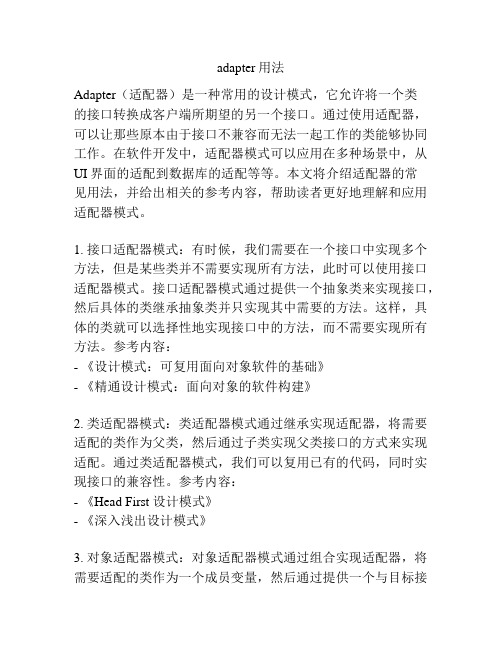
adapter用法Adapter(适配器)是一种常用的设计模式,它允许将一个类的接口转换成客户端所期望的另一个接口。
通过使用适配器,可以让那些原本由于接口不兼容而无法一起工作的类能够协同工作。
在软件开发中,适配器模式可以应用在多种场景中,从UI界面的适配到数据库的适配等等。
本文将介绍适配器的常见用法,并给出相关的参考内容,帮助读者更好地理解和应用适配器模式。
1. 接口适配器模式:有时候,我们需要在一个接口中实现多个方法,但是某些类并不需要实现所有方法,此时可以使用接口适配器模式。
接口适配器模式通过提供一个抽象类来实现接口,然后具体的类继承抽象类并只实现其中需要的方法。
这样,具体的类就可以选择性地实现接口中的方法,而不需要实现所有方法。
参考内容:- 《设计模式:可复用面向对象软件的基础》- 《精通设计模式:面向对象的软件构建》2. 类适配器模式:类适配器模式通过继承实现适配器,将需要适配的类作为父类,然后通过子类实现父类接口的方式来实现适配。
通过类适配器模式,我们可以复用已有的代码,同时实现接口的兼容性。
参考内容:- 《Head First 设计模式》- 《深入浅出设计模式》3. 对象适配器模式:对象适配器模式通过组合实现适配器,将需要适配的类作为一个成员变量,然后通过提供一个与目标接口一致的方法来实现适配。
对象适配器模式比类适配器模式更灵活,因为它可以适配多个类,而不仅仅是一个父类。
参考内容:- 《设计模式之禅》- 《大话设计模式》4. RecyclerView.Adapter:Android中的RecyclerView是一种高度可定制的列表控件,它需要通过一个适配器来提供数据和定义列表项的视图。
RecyclerView.Adapter是RecyclerView的适配器基类,我们可以继承该类来自定义列表项的布局和数据绑定等操作。
参考内容:- 《Android开发艺术探索》- 《第一行代码》5. ArrayAdapter:Android中的ArrayAdapter是一个简单的适配器实现,它可以将一个数组或List中的数据提供给ListView、Spinner等控件使用。
- 1、下载文档前请自行甄别文档内容的完整性,平台不提供额外的编辑、内容补充、找答案等附加服务。
- 2、"仅部分预览"的文档,不可在线预览部分如存在完整性等问题,可反馈申请退款(可完整预览的文档不适用该条件!)。
- 3、如文档侵犯您的权益,请联系客服反馈,我们会尽快为您处理(人工客服工作时间:9:00-18:30)。
UML与设计模式
13/35
适配器(Adapter)设计模式
问题 新旧接口的转换 解决方案 适配器实现新的接口 对旧接口 继承:类适配器 组合:对象适配器 使用 声明新接口的引用
2012年3月
UML与设计模式
14/35
说明:
实现Adapter方式,有两种方式:组合(composition) 和继承(inheritance). 转换一个类的接口为客户端所需要的接口,将两 个不兼容的类纠合在一起使用,这个转换的类就是 适配器类。它属于结构型模式,需要有Adaptee(被 适配者)和Adapter(适配器)两个身份.它的宗旨就是, 保留现有类所提供的服务,向客户提供接口,以满足 客户的期望。
}
2012年3月
UML与设计模式
19/35
类适配器
public class PrintBanner extends Banner implements Print{ public PrintBanner(String str){ super(str); } public void printWeak(){ showWithParen(); } public void printStrong(){ showWithAster(); } }
2012年3月
UML与设计模式
12/35
The Adapter pattern
Convert the interface of a class into another interface clients expect. Adapter lets classes work together that couldn’t otherwise because of incompatible interfaces Applicability: Use when... You want to use an existing class, and its interface does not match the one you need You want to create a reusable class that cooperates with unrelated or unforeseen classes, that is, classes that don’t necessarily have compatible interfaces
UML与设计模式
2012年3月
3/35
History of Design Patterns
Christopher Alexander
The Timeless Way of Building A Pattern Language: Towns, Buildings, Construction
Architecture
2012年3月
UML与设计模式
5/35
Gang of Four (GoF) patterns
Creational Patterns (concerned with abstracting the object-instantiation process) Factory Method Abstract Factory Singleton Builder Prototype Structural Patterns (concerned with how objects/classes can be combined to form larger structures) Adapter Bridge Composite Decorator Facade Flyweight Proxy Behavioral Patterns (concerned with communication between objects) Command Interpreter Iterator Mediator Observer State Strategy Chain of Responsibility Visitor Template Method memento 2012年3月
1970’
Gang of Four (GoF)
Design Patterns: Elements of Reusable Object-Oriented Software
Object Oriented Software Design Other Areas:
1995’
Many Authors
HCI, Organizational Behavior, Education, Concurrent Programming…
2012年3月
UML与设计模式
20/35
类适配器
public class Test{ public static void main(String args[]){ Print p = new PrintBanner("Hello"); p.printWeak(); p.printStrong(); ((PrintBanner)p).showWithParen(); ((PrintBanner)p).showWithAster(); } }
2012年3月
UML与设计模式
22/35
public class PrintBanner implements Print{ private Banner banner; public PrintBanner(String str){ this.banner = new Banner(str); } public void printWeak(){ banner.showWithParen(); } public void printStrong(){ banner.showWithAster(); } } public class Test{ public static void main(String args[]){ Print p = new PrintBanner("Hello"); p.printWeak(); p.printStrong(); }
第二章 UML-类图
Design Patterns Introduction
UML与设计模式
结构型模式
Adapter模式
代理模式
2012年3月
UML与设计模式
1/35
What is a Design Pattern?
A description of a recurrent problem and of the core of possible solutions.
2012年3月
UML与设计模式
21/35
示例二:对象适配器
Main Banner +showWithParen() +showWithAster() <<uses>> 1 1 <<接口>> Print +PrintWeak() +PrintStrong() PrintBanner +printWeak() +printStrong()
In Short, a solution for a typical problem
2012年3月
UML与设计模式
2/35
Why do we need Patterns?
Reusing design knowledge Problems are not always unique. Reusing existing experience might be useful. Patterns give us hints to “where to look for problems”. Establish common terminology Easier to say, "We need a Façade here“. Provide a higher level prospective Frees us from dealing with the details too early In short, it’s a “reference”
UML与设计模式
18/35
类适配器
public interface Print{ public abstract void printWeak(); public abstract void printStrong(); } public class Banner{
private String str; public Banner(String str){ this.str = str; } public void showWithParen(){ System.out.println("(" + str + ")"); } public void showWithAster(){ System.out.println("*" + str + "*"); }
2007’
2012年3月
UML与设计模式
4/35
Types of Design Patterns
Creational Deal with the best way to create objects Structural Ways to bring together groups of objects Behavioral Ways for objects to communicate & interact
8/35
2012年3月
UML与设计模式
适配器(Adapter)设计模式
如果你有一个存在的系统需要插入一个新的类库, 但是新的类库并不能匹配你写的系统,如下图:
